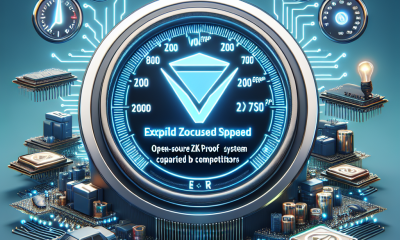Cryptocurrency
Federal Reserve Maintains Current Policy, Notes Stagnation in Inflation Progress

In a recent announcement that has left many market watchers and investors recalibrating their forecasts, the Federal Reserve has affirmed its decision to maintain the current monetary policy steady, pointing to a surprising halt in the progress toward reigning in inflation. This move underscores the complexities facing the U.S. economy, particularly in the face of inflationary pressures that show signs of persistence rather than the anticipated decline.
Over the past few weeks, the optimism that had been building around the possibility of a series of interest rate cuts in 2024 has begun to fade. This change in outlook can be attributed to the economy and inflation displaying an unexpected resilience, suggesting that the path to economic stability and controlled inflation rates may be more protracted and arduous than previously thought.
The Federal Reserve’s stance indicates a cautious approach to monetary policy amidst an economic climate fraught with uncertainties. Despite various measures undertaken to curb inflation, including rate hikes in the preceding periods, the expected downward trajectory in inflation has momentarily stalled. This development is contrary to the predictions of a gradual ease in inflationary pressures, leading many to speculate on the future actions of the Federal Reserve to address this economic conundrum.
The implications of this steadfast approach by the Federal Reserve are multifaceted. For consumers, the persistence of inflation means continued pressure on purchasing power, affecting everything from daily necessities to larger investments. For businesses, the cost of borrowing remains elevated, impacting decisions related to expansion, hiring, and inventory management. Moreover, the stock market, which often reacts to the Federal Reserve’s policy cues, has to recalibrate in light of this new information, impacting investors’ portfolios and strategies.
Inflation, which erodes the purchasing power of consumers and incurs costs on businesses through higher input prices, has been a thorn in the side of the U.S. economy. The Federal Reserve has employed a tight monetary policy as a tool to combat inflation, with interest rate hikes being a primary instrument. These rate hikes are designed to cool down economic activity by making borrowing more expensive, thereby reducing spending and investment.
However, the path to controlling inflation is fraught with trade-offs. While higher interest rates can temper inflation, they also slow down economic growth. This delicate balancing act is at the heart of the Federal Reserve’s policy decisions. The decision to hold policy steady, in this case, suggests that the Federal Reserve is willing to adopt a wait-and-see approach, carefully weighing the risks of prolonged inflation against the potential dampening effects on economic growth.
Looking forward, the anticipation of interest rate cuts in 2024 now appears to be more uncertain. The trajectory of inflation and the overall economic outlook will play critical roles in shaping the Federal Reserve’s future decisions. Should inflation continue to demonstrate resilience or unforeseen economic shocks occur, the Federal Reserve might be compelled to reconsider its stance on maintaining current interest rate levels.
The Federal Reserve’s latest announcement is a sobering reminder of the intricate dynamics of managing a national economy in an unpredictable global landscape. As inflationary pressures persist, the Federal Reserve’s policies will continue to be a focal point for economists, investors, and policymakers alike. The eventual easing of inflation and the return to stable economic growth remain the ultimate goals, but the timeline and path to achieving these objectives are now more uncertain than ever.
In conclusion, the Federal Reserve’s decision to hold policy steady amidst stalled progress on inflation marks a significant moment in the ongoing efforts to steer the U.S. economy towards a sustainable recovery. With the landscape of economic indicators showing unexpected resilience in inflation and economic activity, the road ahead for monetary policy and economic planning appears both challenging and fraught with uncertainties. The implications of this stance are far-reaching, impacting not just the macroeconomic outlook but also the daily lives of consumers and businesses across the nation. As the situation unfolds, all eyes will remain on the Federal Reserve for cues on the future direction of U.S. monetary policy.

Cryptocurrency
Fantom Foundation Boosts Blockchain Performance with Opera Upgrade to Hit 2000 TPS, Following Google Cloud Partnership

Fantom, a prominent player in the blockchain arena, has recently declared the successful deployment of an important upgrade to its flagship Opera chain. This announcement comes shortly after Fantom fortified its technological infrastructure through a strategic alliance with Google Cloud, which marks a significant step in its pursuit of bolstering its blockchain services. The upgrade, which was meticulously devised, has catapulted Fantom’s Opera chain into a new era of efficiency and scalability.
The recent upgrade has impressively catapulted the chain’s capabilities to process up to 2,000 transactions per second (TPS) under normal conditions, and this figure remarkably rises to 4,000 TPS for token swaps and an astounding 10,000 TPS for token transfers. This enhancement not only signifies a monumental leap in operational efficiency but also establishes new benchmarks in the realm of blockchain technology with transaction finality achieved astonishingly within sub-second to 1.6 seconds, varying with transaction types.
The technical enhancements introduced with the Opera upgrade align closely with the aspirations set during the inception of the Sonic testnet in October 2023. Fantom has commendably adhered to its projected timeline, reflecting the team’s commitment and the project’s unwavering dedication to technological innovation. The achievement of a significant 66% consensus threshold marks a pivotal moment, signifying the collective vote of confidence from stakeholders in the platform’s evolutionary journey.
Despite the profound advancements encapsulated within the Sonic network, Fantom has chosen to retain the emblematic “Opera” moniker for its chain. This decision encapsulates a profound sense of identity continuity while embracing forward-looking technological strides. The Opera chain, now more powerful than ever, boasts the potential to manage approximately 180 million transactions on a daily basis, a feat that represents a quantum leap in blockchain capability.
In tandem with these enhancements, Opera’s upgrade also brings about a dramatic reduction in operational exigencies – a 66% decrease in storage requirements, complemented by a staggering 95% reduction in operational category demands. This transformation is not merely technical but extends to economic dimensions as well, promising a substantial surge in transaction volume. This expectation is grounded in the belief that reduced operational costs will catalyze increased activity on the chain.
The seamless transition to a more adept version of the Opera chain signifies Fantom’s resolve to remain at the forefront of blockchain innovation. The anticipation surrounding this upgrade has energized the Fantom ecosystem, instilling optimism about the potential for more robust and user-centric decentralized applications (DApps). This enthusiasm is further amplified by the potential expansion of Fantom’s horizons through additional upcoming initiatives including enhancements in tokenomics, audience engagement, and strategic partnerships.
The introduction of the Sonic Labs and Sonic Foundation marks a crucial evolution in Fantom’s ecosystem, laying a solid foundation for the development of DApps and ensuring sound governance and treasury management. This evolutionary step is perceived as a testament to Fantom’s commitment towards fostering a thriving and dynamic blockchain ecosystem.
The timing of Opera’s upgrade coincides with a notably optimistic market sentiment towards FTM, Fantom’s native token. Despite recent fluctuations, the token exhibits signs of an impending rebound, with its value currently observed at approximately $0.8132, marking a modest increase of 0.92% over the last 24 hours. Market analysts and enthusiasts closely watching the token anticipate this upgrade to significantly bolster Fantom’s market position, heralding a bright future for its ecosystem.
The endeavors of Fantom to continuously innovate and improve upon its offerings reflect a broader commitment within the blockchain industry to achieve scalability, efficiency, and inclusivity. As Fantom’s Opera chain embarks on this new chapter, the broader implications for the blockchain community and its stakeholders are profound, promising an era of accelerated growth, enhanced security, and unparalleled operational proficiency.
Cryptocurrency
OpenAI Gears Up for Exciting ChatGPT Update: New Features and Potential Pricing Changes on the Horizon

The sphere of artificial intelligence (AI) is currently abuzz with anticipation as OpenAI, led by CEO Sam Altman, prepares to introduce its latest innovations. This move is critical as it places OpenAI at the forefront of AI development, potentially altering the competitive landscape against giants such as Elon Musk’s Tesla and Mark Zuckerberg’s Meta. OpenAI is well-known for its generative text AI, ChatGPT, which has revolutionized how users interact with AI, propelling the organization into a tech vanguard position.
Expert predictions, including insights from AI, cybersecurity, and technology aficionado Alvaro Cintas, hint at several potential updates that could be announced. These updates range from the addition of phone calling capabilities to ChatGPT, which would enable users to have real-time conversations, to the integration of a voice assistant designed to rival the likes of Apple’s Siri and Google’s Assistant. This expansion signifies OpenAI’s ambition to create more immersive and interactive platforms where AI can understand, respond, and even interrupt through real-time interactions, thereby enhancing user engagement.
Furthermore, speculation around the GPT-4 API hints at a substantial pricing overhaul. Amidst discussions is the possibility of a dramatic price reduction, signaling OpenAI’s intention to make its services more accessible. Another rumor suggests the introduction of a free usage tier for ChatGPT with GPT-4 access, although with certain limitations. This strategic move could significantly increase the user base by lowering the entry barrier to OpenAI’s cutting-edge technology.
Despite the enthusiasm surrounding the new updates, expectations for the unveiling of GPT-5 remain subdued, with the immediate focus likely to center on enhancing the capabilities beyond the current GPT-4 model. OpenAI has also teased the potential of a new multimodal AI model that not only engages in conversations but can recognize objects, promising a leap forward in AI application and capabilities.
In preparation for the grand reveal on May 13, enhancements to the ChatGPT iOS app have been noted, including updates to the conversational mode and user interface. These preparations are indicative of OpenAI’s commitment to deliver a refined and user-centric experience. However, amidst this excitement, there is an undercurrent of caution as OpenAI navigates regulatory landscapes to ensure compliance and avoid potential legal challenges.
As the artificial intelligence sector waits with bated breath for OpenAI’s announcements, the implications of these updates extend far beyond mere technical advancements. They signify a pivotal moment in AI development, potentially setting new standards for user interaction and accessibility. OpenAI’s steps towards making its technology more inclusive through pricing adjustments, coupled with the introduction of innovative features, could redefine the boundaries of artificial intelligence. These updates are not just improvements but are indicative of the rapid evolution within the AI domain, marking a significant shift towards creating a future where AI becomes a ubiquitous and accessible tool for everyone.
Cryptocurrency
Exploring the Future of Finance: Regulated Settlement Network PoC Aims to Unify Banking and Securities on a Single Platform

In an era where financial transactions are increasingly digitalized, a consortium of leading U.S. financial institutions, including banking giants Citi and JPMorgan, is embarking on a cutting-edge research project known as the Regulated Settlement Network (RSN) proof-of-concept (PoC). This initiative aims to investigate the capabilities and advantages of merging commercial-bank money, wholesale central-bank money, and diverse securities—ranging from U.S. Treasuries to investment-grade debt—within a unified, regulated platform.
This pioneering collaboration signifies a significant leap towards the integration of traditional financial mechanisms with the innovative edge of blockchain technology. The RSN project seeks to create a seamless and secure framework where multiple asset classes can coexist and be transacted efficiently. This could potentially revolutionize how financial entities manage and settle transactions, offering unprecedented levels of liquidity, speed, and transparency across the board.
Digital ledger technology, often associated with cryptocurrencies, has been increasingly recognized for its potential to profoundly transform the financial industry. By enabling real-time settlement of transactions, reducing counterparty risk, and cutting operational costs, this technology promises to enhance the overall stability and efficiency of financial markets. The RSN project stands at the forefront of this transformation, aiming to harness these benefits within a regulated and universally accessible network.
The initiative represents a collaborative effort amongst some of the most influential players in the financial sector. By pooling resources and expertise, these institutions are not only poised to drive innovation within their operations but also set a precedent for the industry’s evolution towards a more interconnected and transparent future. The inclusion of both commercial-bank money and wholesale central-bank money suggests not just an enhancement of interbank transactions but a broader overhaul of the existing financial infrastructure, redefining the landscape of monetary exchanges and securities trading.
Moreover, the focus on incorporating U.S. Treasuries and investment-grade debt into the RSN platform underscores the project’s ambition to cater to a vast array of financial instruments. This approach could pave the way for broader acceptance and use of digital ledger technology across different segments of the market, potentially leading to a holistic transformation of financial settlements.
As the RSN project progresses, its outcomes could serve as a critical case study for regulatory bodies and financial institutions worldwide. The insights gained from this proof-of-concept could inform future policies and frameworks, guiding the integration of digital ledger technology in a manner that supports innovation while ensuring robust standards of security and compliance. Therefore, this initiative is not just about exploring new frontiers in fintech but also about shaping the future regulatory landscape in which these technologies will operate.
Critics and proponents alike will be watching closely as the RSN project unfolds. Given its ambitious scope and the caliber of participants, the venture could potentially set new benchmarks for the adoption of blockchain technology in mainstream finance. Success could herald a new era of multi-asset transactions, characterized by heightened efficiency, security, and interoperability within the global financial system. Conversely, the challenges encountered might offer valuable lessons, framing future discussions and developments in the field.
The journey embarked upon by Citi, JPMorgan, and their partners through the RSN research project is a bold venture into uncharted waters. As the digital evolution of the financial sector accelerates, initiatives like these are crucial for leveraging technology to address longstanding inefficiencies and constraints. While it remains to be seen how this ambitious project will unfold, its implications for the future of finance are undeniably profound.
-

 Cryptocurrency3 months ago
Cryptocurrency3 months agoExploring the Future of Finance: Regulated Settlement Network PoC Aims to Unify Banking and Securities on a Single Platform
-

 Cryptocurrency2 months ago
Cryptocurrency2 months agoFantom Foundation Boosts Blockchain Performance with Opera Upgrade to Hit 2000 TPS, Following Google Cloud Partnership
-

 Cryptocurrency3 months ago
Cryptocurrency3 months agoProtocol Village Announces ‘Expander’: An Open-Source ZK Proof System Doubling Speed Compared to Competitors
-

 Cryptocurrency3 months ago
Cryptocurrency3 months agoOpenAI Gears Up for Exciting ChatGPT Update: New Features and Potential Pricing Changes on the Horizon
-

 Altcoins2 months ago
Altcoins2 months agoFive Altcoins Including Pepe Coin and FLOKI Eye Major Gains: A Path to Turn $10,000 into $1 Million Revealed
-

 Cryptocurrency3 months ago
Cryptocurrency3 months agoMember of REvil Ransomware Syndicate, Rabotnik, Receives 13-Year Jail Sentence
-

 Cryptocurrency3 months ago
Cryptocurrency3 months agoDropbox Suffers Significant Data Breach: A Detailed Look at the Incident
-

 Altcoins2 months ago
Altcoins2 months agoFetch.ai (FET) Faces Potential Correction as Investor Support Wanes and Death Cross Looms


